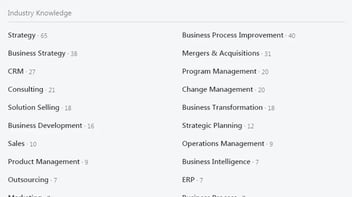5 Tips for Sales Prospecting on LinkedIn
Sales prospecting is a big part of acquiring new customers for any business. Sales teams are constantly trying to better understand what people can be considered prospects and reaching out to them to make a customer out of them. There are many places where sales prospecting can happen, but this article will focus on sales prospecting on Linkedin.
Linkedin, being both a professional hub and a social network, is a great place to look for prospects and contact them. It may seem unusual to be looking for customers on Linkedin, but the opportunity for prospecting is more significant than you think. Here are some things you can do to find new prospects through Linkedin:

Use the "People Also Viewed" Tab.
Thinking of these people as entirely unique as unlike anyone else in the world, is an easy trap to fall into. Luckily, Linkedin tracks how users navigate their platform, and they display some useful information for you.
When visiting a profile, you can see the "People Also Viewed" tab on the sidebar. This tab shows what profiles people who visited the profile you are currently on have visited. Linkedin's algorithm does its best to offer you profiles that are closely related or similar to the one you're now on - and it does a pretty good job at it.
If you've found someone who fits into your sales prospects, you should use this feature. It's an easy and reliable way to let Linkedin's algorithm and user base make your job easier by helping you find more people similar to the ones you've already found. You can easily expand your list of prospects from a few unique profiles to a dozen closely related ones.
Take Advantage of Linkedin's Alumni Search
The traditional search bar is an excellent resource for obtaining most of the information you could be looking for on Linkedin. Still, an extra feature shouldn't be overlooked: alumni search. The Alumni search helps focus your search on people who attended the same school as you.
If you find prospecting difficult and have difficulty breaking the ice with your prospects, then you should consider looking for opportunities through Linkedin's alumni search. Having something as important as education in common with someone makes it much easier to get a conversation going and move forward from there. You can also think of finding prospects through this channel as putting on "training wheels," where you can hone your skills on people you have more in common to later expand and turn any prospect into a customer.
Contact Prospects Who Are Transitioning Jobs
Going from one job to another, or entering a new field in general, is one of the most critical moments for sales prospects. People who are changing jobs are more likely to look into purchasing new and unknown services and products for their new position - new clothes, new accessories, a new phone, subscriptions to efficiency or motivation apps, etc. Frequently this purchasing period is preceded by a fair amount of research, where prospects will look into the services and products they know nothing about to see whether they're worth buying or not.
This is an excellent opportunity to acquire new customers. If you can appeal to that sense of excitement and uncertainty that comes with starting a new job and give prospects the appropriate sense of security and trust they need, then you can bet on them using your services!
Lucky for you, Linkedin is a great platform to keep track of these potential customers. No platform can give you access to a person's employment status as quickly as Linkedin. Usually, people who get a new job will update their Linkedin as soon as possible as part of a new beginning's excitement. That's an opportunity for you and your sales team to take advantage of.
An easy way of figuring out who has changed jobs among your connections is to use the "Notifications" and look at the updates you receive from your connections. If you see a job change, reach out sooner rather than later!
Pay Attention to Competing Networks
Checking out your competition's customers is a great way to approach sales prospecting. As established customers, it's much easier to know what they want and expect from a product or service so that you can cater to that easily. You also understand what your competition offers, so you can carefully build an argument to convince that customer to move away from your competition and start doing business with you.
Most of this information is readily available to you. All you need now is to find your competition's customers.
Linkedin is a great place to start building a list of people doing business with your competition who could be prospective customers of your own. You can easily tap into other Linkedin members' lists of connections and search their networks - your competition is no exception to this. If they're playing their cards right, they're connected to their customers and prospects, so you can quickly determine which connections can be potential customers for your business.
Check Out the People Who Interact With Your Prospects
When working a job, people are usually surrounded by people similar to themselves. Engineers work with a lot of engineers, marketers with a lot of marketers, etc. The same thing happens with consumers. People's social and professional circles are often filled with like-minded people with similar interests, jobs, and hobbies. Linkedin networks follow this trend.
If you're looking for new prospects based on the ones you currently have, you can check out their endorsements. Usually, people get endorsements on Linkedin from people close to them, either personally or professionally, meaning there's a good chance you can find extra prospects from within these endorsements.
For example, you offer an app that helps marketers organize their work. If one of your prospective customers has an endorsement for "Marketing" on Linkedin, the odds are that the person handing out that endorsement could also be another prospective customer.
The good thing about sifting through endorsements is that it's swift and effective. All you need to do is open the list of people who have endorsed your current prospect in relevant areas and then contact these prospects through your sales and marketing teams.
You can do the same thing with other forms of engagement. Comments are a great alternative to endorsements if your prospect is lacking in that area. Browse your prospects' comments the same way you would their endorsements, and try to find other people who would fit the profile you're targeting. A good thing about people who comment is that they're usually active Linkedin users who frequently check the platform. This makes your job easy, as you can use LinkedIn to contact them reliably. You can also respond to their comments and begin interacting with them more naturally than with endorsers.
This content is also available in:
- German: Effektive Kundenakquise auf LinkedIn: 5 Tipps für Ihren Erfolg
- Spanish: 5 consejos para la prospección de ventas en LinkedIn
- French: 5 conseils pour la prospection commerciale sur LinkedIn
- Italian: 5 suggerimenti per la prospezione delle vendite su LinkedIn
- Romanian: 5 sfaturi pentru prospectarea vânzărilor pe LinkedIn
- Chinese: 在 LinkedIn 上寻找销售机会的 5 个技巧

Claudia, a People Operations leader with 9+ years of experience in HR strategy, employer branding, and employee engagement, has guided human resources functions for several high-growth international companies. She played a key role in developing the global employer branding strategy at UiPath during its critical expansion phase. Claudia's expertise lies in scaling People Operations and building the essential HR frameworks that enable dynamic companies to grow effectively.







Leave a Comment